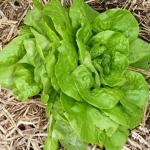Growing Lettuce
lactuca sativa : Asteraceae / the daisy family
| Jan | Feb | Mar | Apr | May | Jun | Jul | Aug | Sep | Oct | Nov | Dec |
|---|---|---|---|---|---|---|---|---|---|---|---|
| S | S | S | S | S | S | S | S | S | S | S | S |
| T | T | T | T | T | T | T | T | T | T | T | T |
| P | P | P | P | P | P | P | P | P | P | P | P |
(Best months for growing Lettuce in Australia - sub-tropical regions)
- S = Plant undercover in seed trays
- T = Plant out (transplant) seedlings
- P = Sow seed
- Easy to grow. Sow in garden, or start in seed trays and plant out in 4-6 weeks.. Sow seed at a depth approximately three times the diameter of the seed. Best planted at soil temperatures between 46°F and 81°F.
- Space plants: 8 - 12 inches apart
- Harvest in 8-12 weeks.
- Compatible with (can grow beside): Carrots, Onions, Strawberries, Beets, Brassicas, Radish, Marigold, Borage, Chervil, Florence fennel, leeks.
- Avoid growing close to: Parsley, Celery
Lettuce offer a range of shapes, sizes and colours but they are all easy to grow.
Choose a variety marked on the seed packet as suitable for the time of year as some do badly in the very hot months.
Try to provide some shade to prevent them 'bolting' to flower and seed in the hottest months.
Sow in rows and use thinnings as small salad greens.
Ideal crop for succession planting.
Lettuce are shallow rooted so water daily in hot or dry weather to prevent bitter flavour. and bolting.
Culinary hints - cooking and eating Lettuce
Wash well, spin or shake dry and use in salads and sandwiches



Your comments and tips